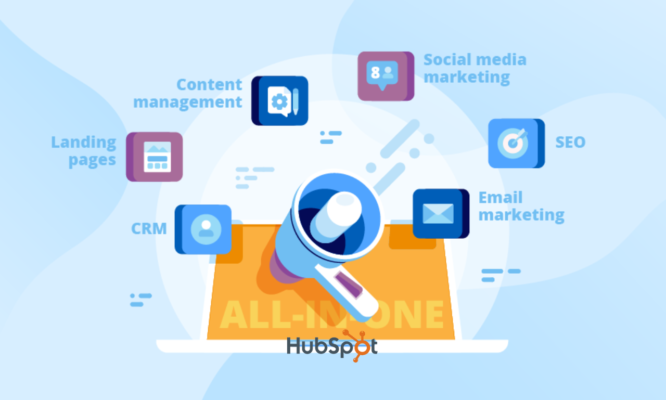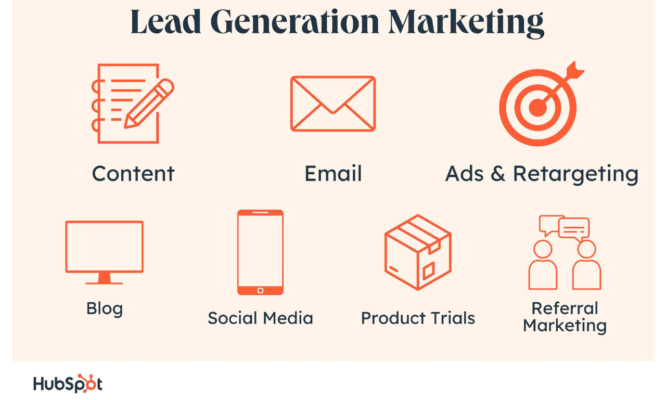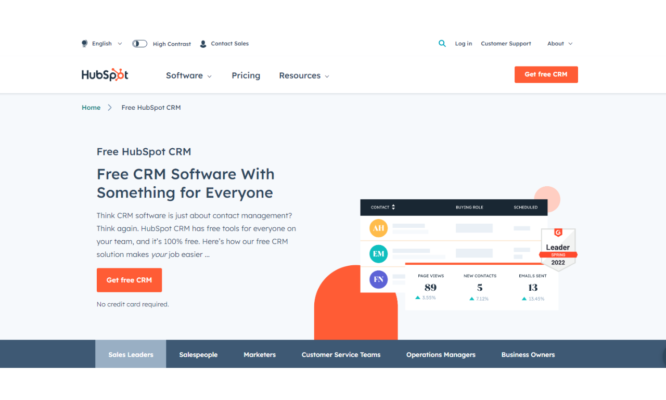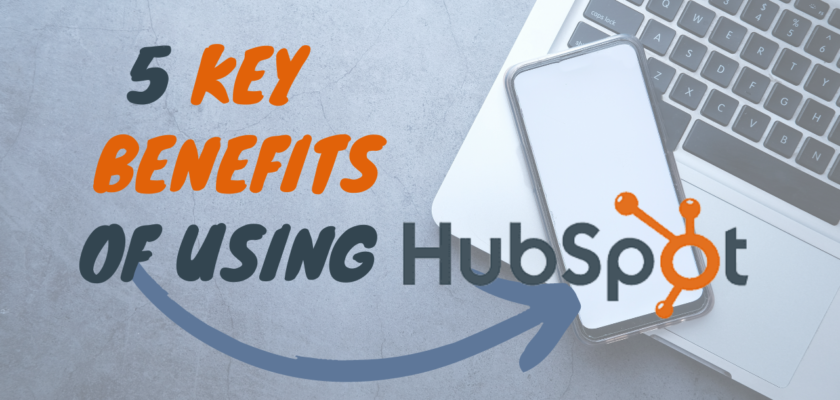Introduction
In today's digital age, businesses are constantly looking for ways to streamline their marketing, sales, and customer relationship management processes. One platform that has been gaining popularity in recent years is HubSpot. HubSpot is an all-in-one marketing platform that offers a wide range of tools to help businesses improve their overall performance.
HubSpot
HubSpot is a cloud-based, all-in-one marketing, sales, and customer service software platform that provides businesses with the tools they need to grow and succeed. The software includes a range of features, including email marketing, social media marketing, content management, customer relationship management (CRM), sales automation, and analytics. HubSpot is designed to help businesses of all sizes attract, engage, and delight customers by providing a seamless experience across all touchpoints.
HubSpot's tools help businesses to generate leads, automate their sales process, manage customer relationships, and track and analyze their marketing campaigns. With HubSpot, businesses can streamline their operations, save time and money, and ultimately grow their revenue.
Read more: The Ultimate Guide to HubSpot Inbound Marketing and Sales Solutions
In this article, we have explored the five key benefits of using HubSpot for your business.
5 Key Benefits of Using HubSpot
Benefit 1: All-in-One Marketing Platform
One of the key benefits of using HubSpot is its all-in-one marketing platform. HubSpot provides businesses with a suite of tools to help them manage all of their marketing activities in one place, from social media marketing and email marketing to content management and analytics. This streamlined approach helps businesses save time and increase efficiency by eliminating the need to use multiple tools from different vendors.

Features of HubSpot's all-in-one marketing platform
HubSpot's all-in-one marketing platform includes a wide range of features designed to help businesses grow and succeed. These features include:
- Social media management tools help businesses manage their social media accounts, schedule posts, and track engagement.
- Email marketing tools that allow businesses to create and send targeted email campaigns to their subscribers.
- Content management tools that enable businesses to create, edit and publish content on their website, blog, or social media channels.
- Marketing automation tools that help businesses automate their marketing workflows and streamline their operations.
- Analytics tools that allow businesses to track and measure the performance of their marketing campaigns and make data-driven decisions.
Benefits for businesses
The all-in-one marketing platform provided by HubSpot offers several real-world benefits for businesses, including:
- Increased efficiency: By using a single platform to manage all of their marketing activities, businesses can save time and improve efficiency
- Improved collaboration: HubSpot's platform allows teams to collaborate more effectively, with shared access to the same data and insights.
- Better customer experience: HubSpot's platform helps businesses create a seamless customer experience across all touchpoints, from social media to email to their website.
- More effective marketing: By having access to all of their marketing data in one place, businesses can make more informed decisions and create more effective marketing campaigns.
Case study
One example of a business that has benefited from HubSpot's all-in-one marketing platform is HealthStream, a provider of workforce development and training solutions for healthcare organizations. Before switching to HubSpot, HealthStream was using multiple tools to manage their marketing activities, which made it difficult to track and measure the performance of their campaigns. By switching to HubSpot's all-in-one marketing platform, HealthStream was able to streamline their marketing efforts, increase efficiency, and improve their overall marketing performance. As a result, they were able to increase their website traffic by 35% and their marketing-generated leads by 80%.
Benefit 2: Enhanced Lead Generation
Another key benefit of using HubSpot is its ability to enhance lead generation. HubSpot provides businesses with a range of tools to help them attract and engage with potential customers, capture their information, and nurture them throughout the buyer's journey. This approach helps businesses to generate more qualified leads, improve their conversion rates, and ultimately increase revenue.

Features of HubSpot's lead generation
HubSpot's lead generation tools include a range of features such as:
- Landing pages that allow businesses to create targeted landing pages that convert visitors into leads.
- Forms that enable businesses to capture visitor information and turn them into leads.
- Lead nurturing tools that allow businesses to engage with their leads throughout the buyer's journey.
- Lead scoring that helps businesses prioritize leads based on their level of engagement and likelihood to convert.
Benefits for businesses
The enhanced lead generation capabilities provided by HubSpot offer several real-world benefits for businesses, including:
- More qualified leads: By using targeted landing pages and lead scoring, businesses can focus their efforts on generating more qualified leads.
- Increased conversion rates: By using lead nurturing tools and providing valuable content, businesses can increase their conversion rates and turn more leads into customers.
- Improved ROI: By generating more qualified leads and increasing conversion rates, businesses can improve their return on investment (ROI) for their marketing campaigns.
- Better alignment between marketing and sales: By using a common set of tools and metrics, businesses can improve alignment between their marketing and sales teams and ensure that they are working towards the same goals.
Case study
One example of a business that has benefited from HubSpot's lead generation tools is Fracture, a company that sells glass photo prints. Before using HubSpot, Fracture was struggling to generate qualified leads and convert them into customers. By implementing HubSpot's lead generation tools, Fracture was able to create targeted landing pages, capture visitor information, and nurture leads throughout the buyer's journey. As a result, they were able to increase their conversion rates by 35% and generate a 57% increase in revenue.
Benefit 3: Improved Sales Process
Another key benefit of using HubSpot is its ability to improve the sales process. HubSpot provides businesses with a range of tools to help them manage their sales pipeline, track their deals, and improve their sales performance. This approach helps businesses to close more deals, improve their win rates, and ultimately increase revenue.
Features of HubSpot's sales tools
HubSpot's sales tools include a range of features such as:
- CRM (customer relationship management) that allows businesses to manage their sales pipeline, track their deals, and store customer information.
- Sales automation that enables businesses to automate their sales workflows and reduce manual tasks.
- Sales analytics that provide businesses with insights into their sales performance and help them make data-driven decisions.
- Email tracking that allows businesses to track when prospects open their emails, click on links, and engage with their content.
Benefits for businesses
The improved sales process provided by HubSpot offers several real-world benefits for businesses, including:
- Increased productivity: By automating manual tasks and streamlining workflows, businesses can improve productivity and reduce the time spent on administrative tasks.
- Improved sales performance: By providing sales teams with access to real-time data and insights, businesses can improve their win rates and close more deals.
- Better customer experience: By using a CRM to store customer information and track interactions, businesses can create a more personalized and engaging customer experience.
- Improved collaboration: By using a common set of tools and metrics, businesses can improve collaboration between their marketing and sales teams and ensure that they are working towards the same goals.
Case study
One example of a business that has benefited from HubSpot's sales tools is Trujay, a data migration service provider. Before using HubSpot, Trujay was struggling to manage their sales pipeline and track their deals effectively. By implementing HubSpot's CRM and sales automation tools, Trujay was able to streamline their sales process, improve productivity, and close more deals. As a result, they were able to increase their sales by 50% and reduce their sales cycle by 30%.
Benefit 4: Better Customer Relationship Management (CRM)
HubSpot offers a powerful CRM (customer relationship management) tool that provides businesses with a central hub to manage all their customer interactions. This feature enables businesses to streamline their customer management process, track customer data and behavior, and create personalized experiences for their customers.

Features of HubSpot's CRM
Some of the features of HubSpot's CRM include:
- Contact management: The CRM enables businesses to store and manage customer data, including contact information, communication history, and interaction details.
- Activity tracking: HubSpot tracks customer activities, such as website visits, email opens, and clicks, to help businesses understand their interests and behavior.
- Deal management: The CRM allows businesses to track the progress of deals, manage tasks, and schedule appointments.
- Lead generation: HubSpot's CRM integrates with its marketing tools to enable businesses to generate and capture leads, and manage them in the same platform.
Benefits for businesses
The better customer relationship management provided by HubSpot's CRM offers several real-world benefits for businesses, including:
- Improved customer experiences: With a better understanding of their customers, businesses can create personalized experiences that build trust and loyalty.
- Increased efficiency: By managing customer interactions in one place, businesses can streamline their processes and improve their overall efficiency.
- Enhanced sales: HubSpot's CRM makes it easier to identify opportunities and track deals, resulting in more successful sales.
- Better collaboration: With access to the same customer data, businesses can improve collaboration between their sales, marketing, and customer service teams.
Case study
One example of a business that has benefited from HubSpot's CRM is Oxfam Australia, a charity organization. Before using HubSpot, Oxfam Australia struggled to manage their donor data effectively, leading to lost opportunities and inefficient processes. By implementing HubSpot's CRM, Oxfam Australia was able to streamline their donor management process, track interactions, and create personalized communication. As a result, they were able to increase donations by 70% and improve their donor retention rate by 60%.
Benefit 5: Actionable Analytics
HubSpot's analytics feature provides businesses with valuable insights into their marketing, sales, and customer service efforts. This feature enables businesses to measure their campaigns' effectiveness, identify improvement areas, and make data-driven decisions.

Features of HubSpot's analytics
Some of the features of HubSpot's analytics include:
- Website analytics: HubSpot's website analytics tool provides businesses with information on website traffic, visitor behavior, and engagement metrics.
- Email analytics: The platform's email analytics feature enables businesses to track email opens, clicks, and conversions.
- Campaign analytics: HubSpot's campaign analytics feature allows businesses to track the performance of their marketing campaigns, including social media, email, and ads.
- Sales analytics: HubSpot's sales analytics feature provides businesses with insights into their sales activities, including deals closed, deal stages, and revenue generated.
Benefits for businesses
The actionable analytics provided by HubSpot offers several real-world benefits for businesses, including:
- Improved ROI: By analyzing campaign performance and identifying areas for improvement, businesses can increase their ROI and achieve better results with less effort.
- More effective decision-making: With access to data-driven insights, businesses can make more informed decisions and take actions that drive success.
- Better alignment: The analytics feature enables businesses to align their marketing, sales, and customer service efforts to improve overall performance.
- Continuous improvement: By tracking performance and analyzing results, businesses can continuously improve their strategies and achieve better results over time.
Case study
One example of a business that has benefited from HubSpot's analytics feature is Media Junction, a marketing agency. Before using HubSpot, Media Junction struggled to measure the ROI of their marketing efforts and track the performance of their campaigns. By implementing HubSpot's analytics feature, they were able to gain valuable insights into their marketing performance, identify areas for improvement, and make data-driven decisions. As a result, they were able to increase their website traffic by 194%, generate 3 times more leads, and achieve a 150% increase in revenue.
How to Get Started with HubSpot?
Getting started with HubSpot is a straightforward process. To get started, you need to sign up for an account and select the HubSpot tools that best fit your business needs. Once you have selected the tools you need, you can start setting up your account and integrating it with your existing systems.
Step-by-step guide on setting up an account
Here is a step-by-step guide to setting up your HubSpot account:
- Sign up for an account: Go to the HubSpot website and click on the “Get Started for Free” button. Enter your name, email address, and website URL to create your account.
- Choose your plan: HubSpot offers a variety of plans, including a free plan, so you can choose the plan that best fits your business needs.
- Set up your account: Once you have selected your plan, you can start setting up your account. Follow the prompts to enter your company information, connect your social media accounts, and set up your sales pipeline.
- Integrate your systems: HubSpot offers integrations with a variety of other platforms, including Salesforce, WordPress, and Shopify. If you use any of these platforms, you can integrate them with HubSpot to streamline your workflows.
- Set up your campaigns: With your account set up, you can start creating and launching campaigns using HubSpot's marketing tools, including email marketing, social media, and ad management.
Conclusion
If you're interested in trying HubSpot for your business, the first step is to sign up for a free account and explore the platform's features. With its easy-to-use interface, comprehensive analytics, and powerful marketing and sales tools, HubSpot is a great investment for businesses of all sizes. So why not give it a try today and see the benefits for yourself?




